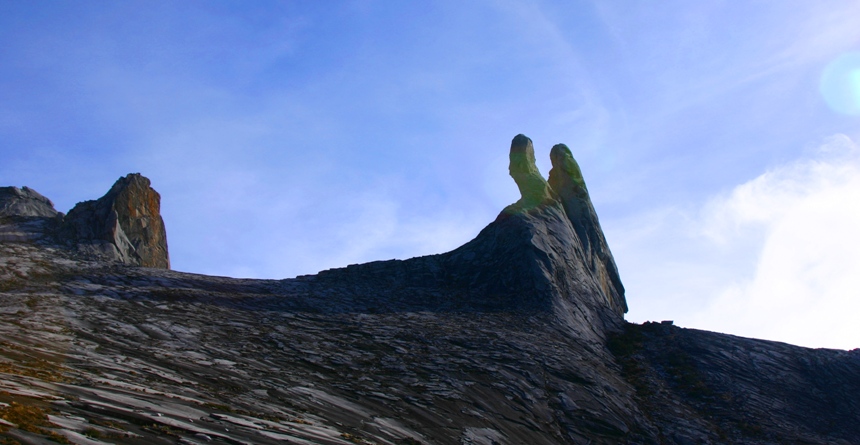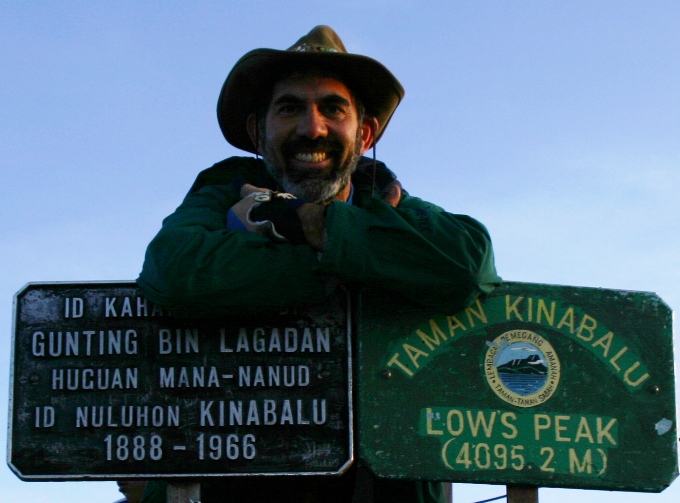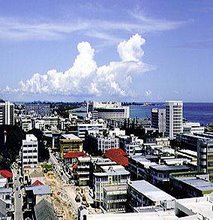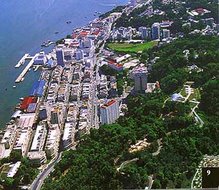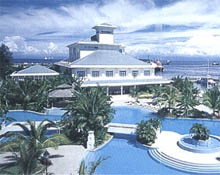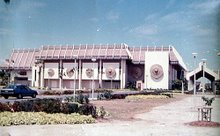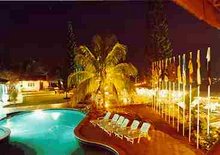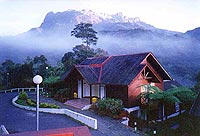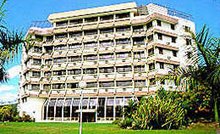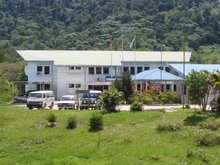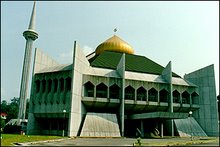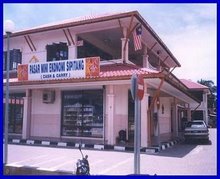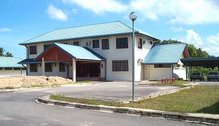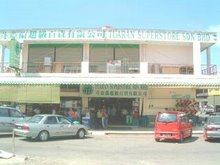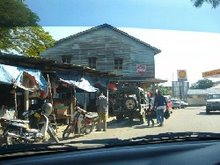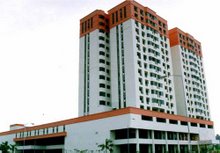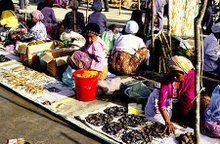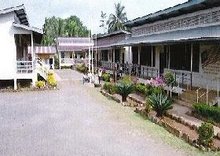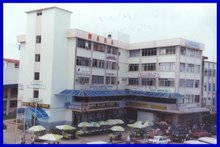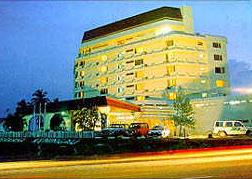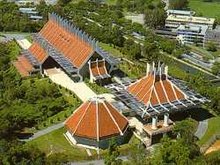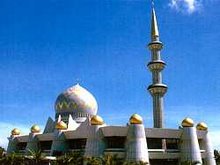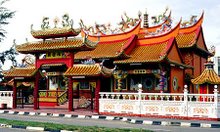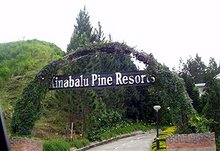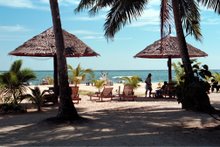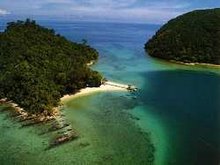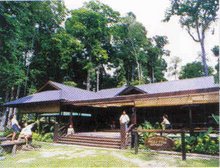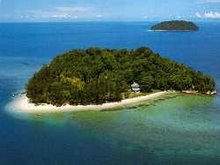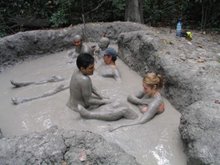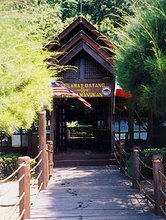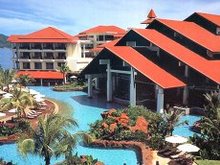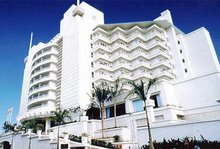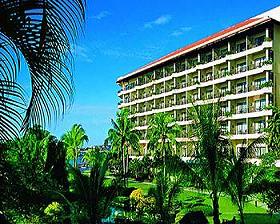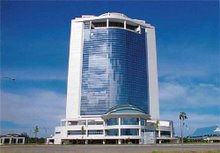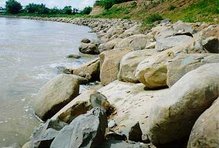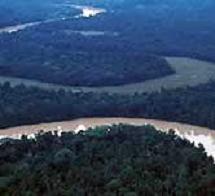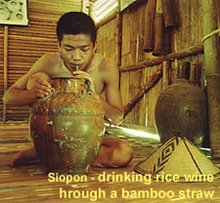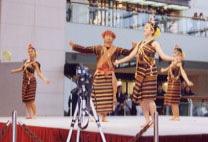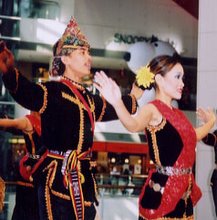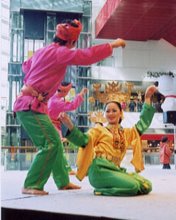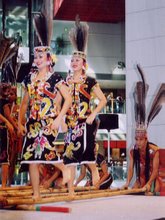about pulau tiga island,kinabatangan,selingan island,gomantong caves and danum valley
island of pulau tigaThe tropical island bursts with color. Orange and pink sunsets. Blue-green waters. And purple neon.

"Survivor Bar," says the sign at the new Pulau Tiga Resort, which Malaysia hopes to turn into a hit tourist destination by capitalizing on the fact that the CBS Survivor TV reality show, which premiered this week , was filmed here.
"A lot of Americans don't even know where Malaysia is," laments Noredah Othman, a marketing manager for the area's tourism bureau.

Millions more will as they watch 16 Americans, "marooned" on the island to film the 13-episode show, do such things as eat worms and jungle rats in a series of games over 39 days. Contestants gradually vote each other off the island. The sole survivor wins $1 million.
By the shore of Pulau Tiga: The tropical island off Malaysia is becoming remotely familiar to viewers of CBS' 'Survivor' series. (CBS)The resort hopes to open in a month. The gift shop is already stocked with "I survived Pulau Tiga" T-shirts. Several props used in the show, including a replica of a B-52 fuselage, were saved to serve as points of interest, and resort workers are quick to point out the contestants' campsites and even the now-covered pit they used as a toilet.
In addition to marketing the resort as a water-sport and jungle retreat, manager Bonnie Alberto says he may run guests, especially high-achieving business types, through Survivor-like contests. Otherwise, he says, "after two or three days, they might get bored."
Located off the coast of Sabah state in Malaysian Borneo, Pulau Tiga is a tropical island with thick jungles, white-sand beaches and coral reefs.
It's remote location, though, 90 minutes by car from Sabah's capital of Kota Kinabalu and then 30 minutes by speedboat, is a deterrent. Last year, only about 170 international tourists visited.

Initially planned to have 30 beds, the resort was expanded to 80 after CBS chose Pulau Tiga and needed more housing for the crew. Proceeds from Survivor funded much of the resort's construction.
While remote, Pulau Tiga wasn't uninhabited, as CBS first claimed. Pulau Tiga National Park employees, now numbering 17, have lived on the island for years. The island-wide park even rents out a chalet and dormitory that sleeps 16.

The Survivor contestants also weren't exactly marooned. More than 100 CBS crew and support staff were on the island during filming, including three medical personnel. The contestants were confined to a separate part of the island, however. Except for some props and a few piles of wood, few signs of the filming remain. Styrofoam boulders brought in were removed, as were the contestants' shelters.
Park rules threaten three-year jail terms for anyone who disturbs so much as a rock, but allowances were made for Survivor.
Club Med it is not, but surviving Pulau Tiga Resort as a tourist won't be tough - unless one is squeamish about rats. Despite attempts to trim the hardy population with traps, "they keep coming back," says Terence Lim, resort project manager.

The resort, just off the beach, has four air-conditioned cabins, which include hot showers, refrigerators and decks. Another 23 cabins, hastily constructed to accommodate the CBS crew, have ceiling fans and cold showers.
Dormitory-style rooms also are available. Lodging costs will range from about $30 to $92 per night, Lim says.
Meals will be taken in the central lodge, which includes the dining deck, Survivor Bar, a video room and a game room. Malaysian, Chinese and American meals, probably served family-style, will cost about $5 each.
Part of the 2,000-acre island is fringed by coral reefs, which are good for snorkeling. The island lacks roads, but 7 miles of hiking trails pass a 5- foot-wide volcano that gently oozes mud and follow the shore past three main beaches.
Macaque monkeys and harmless lizards move around the jungle - and sometimes the resort grounds. Insect repellent is a must.
Ten minutes away by boat is nearby Snake Island, a small dot of land named after its population of poisonous sea snakes, which move about mostly at night.
Also close: a quarter-mile-long sand spit that juts into the sea, offering a glorious spot to sunbathe, swim and picnic.
It is truly uninhabited.

The games room provide an array of board games, dart board, a pool table and karaoke facility for those who would like to try out their vocal talents. The TV viewing room is fitted with a satellite channel to catch on the latest development around the world. T-shirts and other souvenirs are made available at the nearby Novitan gift shop.
kinabatangan river and kinabatangan basinThe Kinabatangan River is one of the longest rivers in Malaysia.
The Kinabatangan River is one of the best places in Borneo – indeed in all of South East Asia – to observe wildlife. A boat trip on the Kinabatangan River is a highlight of any nature-lovers’ trip to Sabah.
Lying within the vast floodplain of the Kinabatangan River is the Kinabatangan Wildlife Sanctuary. The Kinabatangan Wildlife Sanctuary spreads over 27,000 hectares and is part of a vital network of conservation areas in the lowlands of eastern Sabah. Together with existing Forest Reserves, a natural corridor of natural vegetation links the lower tidal reaches of the r

iver (which are fringed with mangrove forests) to the seemingly endless forest in the upper catchments of the Kinabatangan River. Kinabatangan Wildlife Sanctuary is by far the most fascinating of natural protected areas in Sabah where abundance of fauna, diversity of wildlife and a rich culture and history of the Orang Sungai (in Malay, river people) offers visitors to the Kinabatangan Wildlife Sanctuary amazing and spectacular experience.
Where the Kinabatangan River meets the lowland areas, a rich mosaic of lowland forests, forested swamps and islands of limestone outcrops are found. These natural forests represent one of the largest floodplain forests of Malaysia. Floodplain forests are unlike the lowland forests that were once common throughout Eastern Sabah. Forests that develop here need to be able to tolerate periodic inundation of flood water during the monsoon season. In areas where the land remains under water for long periods, the forest give way to open woodlands or to herbaceous swamps that are sometimes almost entirely carpeted with sedges and grasses. Ox-bow lakes are a

lso a common feature of the floodplain. Over time, these lakes too will be part of the floodplain landscape as the lakes become filled up with alluvial sediments and begin to be colonised by swamp vegetation.
The abundance and rich diversity of wildlife are evident in the floodplain. The varieties of primate that inhabit these forests are astounding: Orang Utans, gibbons, Proboscis monkeys are three of its most charismatic primates. Other less often seen species are the nocturnal flying lemur, slow loris and tarsiers. During the drier months of the year, the Asian Elephant (an endangered species) roam these forests during their annual migration to the floodplain. Hornbills and an array of wild and endangered birds, feast on a multitude of fleshy fruits that can be found in these forests. The Kinabatangan River is also home to a large variety of aquatic wildlife. Freshwater fish such as rays and freshwater sharks, crocodiles and wild otters swims freely in the Kinabatangan River.

The Orang Sungai, literally translated means River People (a generic term used to describe the people who settled along rivers) are of a mixed and diverse heritage. Over the centuries, the true natives had intermarried with traders and settlers who have made their way to the Kinabatangan plain. The forest and rivers have been essential to the livelihood of the Orang Sungai. Working to maintain balance between the wise use of this unique floodplain and its conservation has been the key to the conservation efforts in the Kinabatangan plain. WWF-Malaysia Projects Director wrote that, "....right here in the lower Kinabatangan, some of Malaysia’s and Borneo’s rarest wildlife achieves its greatest abundance alongside people collecting rattan and fishing for their livelihood. A balance can be achieved, which should be the goal for the future of the people and forests of the Kinabatangan”.

LOWER KINABATANGAN RIVER
On 16 November 1999, the Lower Kinabatangan River was pronounced a “Gift to the Earth” by YAB Datuk Chong Kah Kiat, then the Chief Minister of Sabah, during the WWF Annual Conference held in Kota Kinabalu.
It is said that the Chinese Imperial merchants sailed up the Kinabatangan River in search of the precious bird's nests. Its floodplains are one of the most exceptional areas in Malaysia. Influenced by the tides of the Sulu Sea and rainfall in the interior, the lower part of the river plain floods regularly. Thus over the centuries, 5 distinct habitats have evolved: waterlogged and dry forests, saline and freshwater swamps and limestone forests; each contributing towards some of the most diverse concentrations of wildlife in Borneo.

The lower river basin of the 560 km long Kinabatangan River covers almost 4,000 square kilometres of Sabah. The mangrove swamps fringing the mouth of the river protect the coast from erosion and are a valuable nursery grounds for replenishing marine resources. To the west, a vast area of commercial forest reserve is testing ground for sustainable forest management. Unfortunately, much of the floodplain is already covered by oil palm plantations. The remaining pockets of fresh water swamp forest, lowland riverine forests and dryland forests are home to some of the largest and most diverse concentrations of wildlife species in Borneo, making the lower Kinabatangan increasingly interesting for scientists and visitors alike, especially those in search of wil

dlife, and eco-tourism.
A dawn or dusk river ride past mangrove-filled swamps promises exciting sightings of wildlife. A view that never fails to delight is a glimpse of the playful proboscis monkeys. These huge-bellied, long-nosed primates with long white tails live by the river and are especially active during these hours when they are socialising, crashing through trees or foraging for food.
selingan islandThe Turtle Islands Park lies 40 km north of Sandakan in the Sulu Sea off Sabah's east coast. It encompasses 1,740 hectares which include the three islands of Selingan Island, Bakkungan Kecil Island and Gulisan Island, together with the surrounding sea and coral reefs. The islands are built over shallow rocky shoals from coral shingle from the surrounding re

ef. They are covered with a variety of plant life which include mangrove, lantana, the yellow-flowered Sophora and the furry silver-leaved Tournefortia. The main attractions here, however, are the turtles which come to nest on the shores. Selingan Island is the biggest of the Turtle Islands and has been developed to house basic tourist facilities and the park’s headquarters, visitors’ centre and turtle hatchery.
Turtle eggs have been collected from the islands since before the colonial days. All the islands were populated until the late 1960s, but conservation awareness and efforts to protect marine turtles around the cast of Sabah were realised as early

as 1927 when the British North Borneo Chartered Company first imposed restricted hunting of the Hawksbill Turtle for their meat and shells. In 1966, it was on Selingan that the first turtle hatchery in Malaysia was established. In 1971, the Sabah Government acquired the three islands from private ownership, and i

n 1972, the islands were constituted as Game and Bird Sanctuaries. Finally in late 1977, the Government converted the three islands into the present 1,740 hectare marine park embracing not only the islands but also the surrounding coral reefs and the seas between the islands, and the Turtle Islands Park came into being. The turtle conservation programme has proven to be very successful and detailed statistics show that the decline in turtles has been minimised.
Although they come up to nest throughout the year, the peak season for the Green turtles is between August to October while the Hawksbill turtles come up in force between February to April each year. Turtle landings usually occur after dusk and the best time for viewing them is on full moon nights as artificial lights and noise usually scare them away. The park has a sensible policy of allowing visitors to see only one landing a night. This allows undisturbed nesting to go on throughout the night. During the day, the west side of the island offers interesting coral and sea life for a decent day’s snorkelling.

Dive into these waters and marvel at how the turtles are like ballerinas floating amidst the corals, foraging for food before their next breath of air. At night, crouch quietly as park rangers point out the turtles laying their eggs. They go throug

h a slow ritual of digging, laying and burying before making their way back into the water. Park rangers then carefully transfer around 100 eggs every night into a safe haven for monitoring, hatching and subsequent release into the sea.
gomantong caves
the best managed edible birds' nest cave in the world", Gomantong Caves has been the focus for birds' nests for centuries. Located on the Southwest of Sandakan, the Gomantong Caves has considerable historical depth. Records have traced these caves as an important source of this precious delicacy to the Chinese Emperor centuries ago. Within the intricate system of the Gomantong Caves are two complexes - Simud Hitam and Simud Putih. The easy accessible Simud Hitam, which rises to 90 metres

high, produces black saliva nests, while Simud Putih is harder to reach but produces the more valuable white nests.Twice a year, local licensed collectors risk their lives climbing to the roof of these cave complexes in a dangerous operation that involves only rattan ladders, ropes and poles. These caves are protected by the Wildlife Department which only allows the collection twice yearly. Catch the collectors in action between February and April, when the nests are first harvested just after the birds have built them, or between July and September, when the newly rebuilt nests are abandoned after eggs have hatched. The Gomantong Caves is home to a rich range of birds, including Crested Serpent Eagles, Kingfishers, Asian Fairy Bluebirds and Leafbirds.

Caving Tips :
•
Trips to the 'show caves' require no special equipment and can be done year-round.
•
For recreational caving, a safety helmet and torchlight are all that is needed. Serious caving may require extra equipment like carbide lamps, harnesses, karabiners and ropes.
•
Tell a responsible person where you are going and when you plan to return.
•
Minimum group size is three persons, although four is probably optimal. Always go with a seasoned guide who can be hired from the National Parks or caving clubs. Make sure everyone in the group has safety gear (check that it is in working order), and knows how to take care of caves.
•
Don't overdo the trip. Most caves take less than three hours to explore. Even so, never go in a cave for more than eight hours at a stretch.
•
Always note landmarks and look behind you: the cave will look very different on your way out
danum valey
Nestled in the interior of Sabah, 83km southeast of east coast town Lahad Datu, the Danum Valley Conservation Area is one of the last remaining preserves of primary lowland rainforest in Asia. The Danum Valley provides visitors with an unparalleled ecological experience into the wonders of ancient tropical forests.

Danum Valley was formerly part of a 972,000 hectare forest concession assigned
to the Sabah Foundation by the State Government. In May 1995, the area was declared a Class I (Protection) Forest Reserve by the Sabah Legislative Assembly, prohibiting the issue of timber and logging concessions. Currently the Sabah Foundation works to make Danum Valley a center for wildlife research, education and eco-tourism. The Foundation also provides infrastructural support in the form of road access, radio communication and manpower to assist the state authorities in conserving Danum Valley and supporting the development of scientific and commercial establishments for research purposes.

Considered today as one of the premier research centres in South East Asia, the Danum Valley Conservation Area oversees research projects, controls forest enrichment planning sites, education, training and wilderness recreation and is a meeting place for naturalists from all over the world.
Within its 438 square kilometers the rich diversity of animal and plant life display the complex interaction of a natural, dynamic ecosystem found only in rainforests. The hot and humid jungle teems with a variety of towering tropical trees, lingering lianas, exotic orchids and overhanging epiphytes. There are few places on earth that can provide such an awe-inspiring spectacle of nature in its original, pristine state.

DANUM VALLEY BORNEO RAINFOREST
Visit the Danum Valley Rainforest, a vast, pristine rainforest inhabited by wild orang utans, extremely rare and elusive Sumatran rhinos, and some of Borneo's last Asian elephants – majestic creatures whose survival is a critical priority for WWF.
Borneo's lush rainforests engulf a region serrated with jagged peaks, carved by ancient rivers into sheer valleys that shelter prolific wildlife and diverse indigenous tribes, living off the land much as they have done for thousands of years. The 100-million-year-old rainforest of Danum Valley is said to be the oldest and tallest virgin rainforest in the world.


DANUM VALLEY BORNEO RAINFOREST LODGE
The Borneo Rainforest Lodge is the only accommodation facility in Danum Valley. Designed for wildlife observation, the Borneo Rainforest Lodge offers large, open public spaces, well-marked nature trails, a canopy walkway for tree-level viewing, and an outstanding team of naturalists and guides.

Made from river stone and core logs, the chalets are designed along the lines of traditional Kadazandusun dwellings and linked together by walkways. The lodge is open 12 months a year. A three days, two night stay is recommended. There is also a camp-bed facility (tented camp) 7km from the lodge where visitors can spend the night under the watchful protection of a field guide.
The Borneo Rainforest Lodge has developed out of the success of the nearby Danum Valley Field Centre, one of the foremost research and environmental education establishments in South East Asia.
This is the destination for visitors who yearn to see wildlife in a primeval Borneo rainforest and to understand the conservation realities of our times.
PLACES OF INTEREST AT DANUM VALLEY

Although Danum Valley is essentially a conservation area it is also a wonderful retreat for nature lovers and naturalists. The Borneo Rainforest Lodge provides many nature activities, including :
•
nature walks with knowledgeable guides who will point out interesting flora and fauna and lead you through undisturbed riverine and lowland dipterocarp forests.
• jungle wildlife treks along an escarpment trail with panoramic views over orang utan habitats
• canopy walkway where bird watching can be carried out
• visits to an ancient Kadazandusun burial site
• night safari drive in open jeeps in search of wildlife
• refreshing swims in rivers and waterfalls
• day trips to Danum Valley Field Center
• slide presentations by naturalists
• guided tours to reforestation and research areas
The many viewing platforms perched on high plateaus overlook panoramic vistas and observation decks attached to mighty tropical timbers allow a visitor closer access into the forest canopy. The 27 meter high L-shaped canopy walkway anchored by sturdy Mengaris and Majau trees gives visitors a bird's eye view of the forest and is a perfect vantage point for bird watching.
Standing under the green cover of the rainforest while being encircled by the immense diversity of plants, one cannot help but marvel at the spectacle which took nature centuries to complete. A seemingly limitless bounty of orchids, ferns, fruit trees, lichens and lianas are unveiled as jungle trails through Danum take you into the heart of the natural world. With over 50 kilometers of cool hiking trails through the dipterocarp forest and riverine habitats, a trip into the forest become a new learning experience as knowledgeable guides point out things easily missed by untrained eyes. Take particular note that no visitor is allowed to trek or jungle walk without being accompanied by a guide for their own safety.
FLORA & FAUNA IN DANUM VALLEY
Undoubtedly, the wildlife in Danum makes for a memorable experience. Some of the rarest species in Borneo are found in this valley and it is here that sightings of the clouded leopard or Sumatran rhino have occurred. For the nature lover, Danum Valley is a picture book of the exotic and beautiful.

Unlike the African savannah, wildlife in the lowland rainforests of Borneo is not always easy to sight. To spot nocturnal creatures like the leopard cat or clouded leopard who only wake and hunt for food in the dark, one must be prepared to forego sleep and spend many hours waiting and watching patiently.
Danum is also a bird watchers' paradise. With every layer of forest providing shelter for Danum's birdlife, visitors must sharpen their senses and be constantly on the look out for elusive species by their calls, movements or markings. Patient scrutiny is sure to be rewarded with a decent list of sightings. Usually the sightings will intensify during the fruiting season between July to August.
Some Birds found in Danum Valley
•
Bay owl
• Bill fletcher
•
Crested fireback pheasant
• Great argus pheasant
• Black-backed kingfisher
• Lesser green leafbird
• Bornean flycatcher
• Blue-headed pitta
• Crimson sunbird
• Asian fairy bluebird
• Grey-breasted spiderhunter
• Spectacled bulbul
• Buffy fish owl
• Helmeted & wreathed hornbill
• Bushy-crested & pied hornbill
• Rhinoceros hornbill
Some Mammals found in Danum Valley
•
Clouded leopard
• Giant flying squirrel
•
Lain pygmy squirrel
• Malayan sun bear
• Bateng
• Smooth otter
• Silvered langur
• Proboscis monkey
• Sumatran rhino
• Orang utan
• Western tarsier
• Flying lemur
• Leopard cat
• Yellow barking deer
• Mousedeer
• Sambar deer
• Bearded pig
• Malay civet
• Long-tailed macaque
• Slow loris
• Asian elephant
Although not everyone's favorite creatures, insects are one of Danum Valley's most fascinating inhabitants. Danum supports thousands of these little known but very important inhabitants of the tropical rainforest. With only a few stinging bees and wasps, most of the insect colony are harmless and deserve the attention given to their larger counterparts. Take time to find butterflies like the Chocolate Soldier, look closely for the cleverly camouflaged Spiny Stick Insect which appears at first glance to be a twig; and listen to the song of the cicadas as they add their chirping to the natural music of Danum.
HOW TO GET TO DANUM VALLEY
Bordered by the Segama and Danum Rivers, Danum Valley is a rugged terrain of gently sloping inclines with elevation less than 760 meters in most places, descending into level riverine habitats.
Danum Valley is located 80km inland from Lahad Datu on Sabah's east coast. The journey takes approximately 2 hours with the first 15km being the main Lahad Datu-Tawau road. The rest of the ride is on an unsealed but well maintained private logging road. While it is possible to take your own transport, permits have to be obtained beforehand. It's better to use the pick-up services provided by the Borneo Rainforest Lodge.

Practical Tips
Visitors are advised to bring along light cotton tops, long pants and sturdy walking or hiking shoes and a container of drinking water to prevent dehydration during their walks.
There are nominal charges imposed on visitors to Danum Valley. Entrance permit fees range from RM4 per day to RM30 for a residential visit. A fee is also levied for the use of cameras and video cameras. Collections go to a Trust Fund for conservation activities.

Visitors are reminded not to hurt, frighten or disturb any animal or bird; or attempt to smuggle any forest inhabitant out of the Valley. There is a penalty for defacing, destroying or harming the flora and fauna in Danum.



